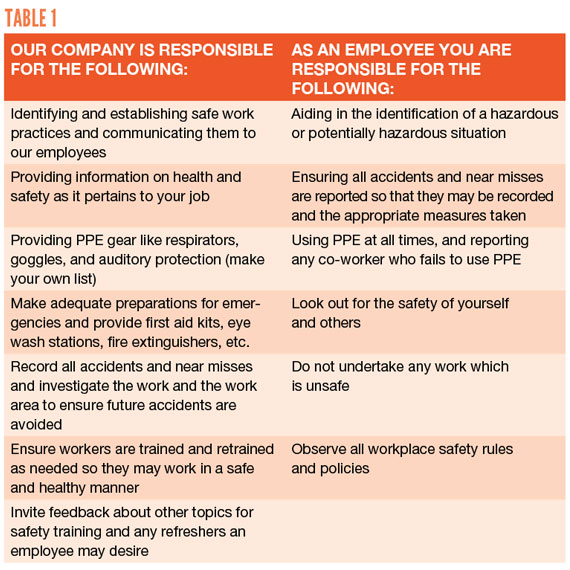
Small Business Documents, Part IV
The Company Handbook (from the Company Welcome to Vehicle Policy)
By Beth Borrego / Published November 2022

Editor’s Note: Parts I and II in this series, “Small Business Documents: Protecting and Running Your Business,” were published in the June and July 2022 issues of CT respectively. Part III “Small Business Documents: Performance & Disciplinary Reviews” was published in the October 2022 issue. To read the first three parts, visit www.cleanertimes.com.
Perhaps one of the most daunting documents to create is the company handbook, also known as a company manual, employee manual, or employee handbook. For our purposes, we’ll refer to it as a handbook. This document is an extremely important part of your business. The handbook is a valuable document for both the employer and the employees alike, outlining and defining the history of the company; its vision, policies, and procedures on a variety of topics; and any benefits. A well-written handbook should clearly define the expectations that your company has for all employees, full time or part time, and should speak to expected conduct and the company culture. It’s important to mention that writing a handbook is not a one-and-done thing; it should be reviewed at least annually since state and federal laws may change, impacting the contents of the handbook. The handbook, while it may be an important structural guide to employees, also serves to protect your company from potential legal action.
It’s important to specify the employment relationship clearly and early on in the handbook, as well as at the end of the handbook on the signature page and in any other areas such as sections about disciplinary actions and termination, for clarity. Expected behaviors, boundaries, company policies, code of conduct, performance reviews and discipline, benefits, dress code, leave, compensation, and your drug and alcohol policy are just some of the topics to include in your handbook. Many states are work at-will states, and the inclusion of the at-will statement is critical in protecting your business. Likewise, if your business is located in a right-to-work state, your handbook should appropriately reflect it. Right-to-work legislation is legislation allowing a person to work at any place of employment without being forced to join a union as a condition of employment.
Many companies consider a new hire to be in a probationary period lasting anywhere from 30–180 days in length or as long as one year. However, this is not necessarily a good idea. Many states are work at-will states, and when an employee passes a probationary period, the concern is that the employee may be deemed more permanent than they were during the probationary period. It is important to hire a labor and employment attorney to review your company handbook to help to ensure that you are not leaving your company vulnerable when you really want a status such as work at will or right to work to remain in your favor.
Let’s take a closer look at what the sections of the handbook might look like or contain. Of course, you’ll need to have a table of contents naming each section of the handbook and referencing the appropriate page numbers.
Welcome to the company—include a statement of welcome from the owners to the new hire.
Company history—include information on the company history. Understanding its beginnings helps employees to understand what they are becoming a part of.
Mission statement—include the company mission statement. You should have this information in your business plan.
Completion of forms—include a list of forms to be completed and the requirements for each one. Some of these may include Form W-4, Form I-9, any state forms that may be required in your area, a non-disclosure form, non-compete form, emergency contact form, and any payroll forms that may need to be filled out for things like direct deposit.
Work hours and expectations—outline the expectations for day, evening, and night shifts, and overtime, weekend, holiday, and out-of-town work. Employment classifications should also be included. Clearly define classifications, such as full-time, part-time, exempt, or non-exempt, since an employee’s classification can dictate eligibility for benefits and overtime pay. If you have out-of-town work, a section dedicated to out-of-town work is warranted and will be listed later on in the manual.
Personal vehicles and parking—discuss parking availability at your location and any building access employees may need.
Company dress code—define your company dress policy stating clearly what is and is not permitted attire. If uniforms are part of the dress code, outline any information regarding the uniforms, and how they are obtained, laundered, and returned to the company. Be sure to make clear what violating the dress code means and what it will result in.
Payroll matters—make sure to outline clearly and specifically what your payroll schedule is. Mention the frequency of performance evaluations. Note that all payroll deductions are based upon the tax information provided by the employee and that your company is not a tax advisor nor can you offer suggestions about tax withholding. State that should your company receive notice from either a state or federal agency regarding wage garnishment for taxes owed, child support, or any other unknown reason, you have no choice but to comply with the withholding order and will provide the employee with a copy of the order. It is also a good idea to mention that all payroll-related topics are deemed confidential between the employer and employee. However, be careful not to limit wage discussion between employees as it may be a violation of their rights and against the law to do so.
Open door policy—encourage your employees to bring any issues or concerns directly to their supervisor. Make it clear that discussion among other employees about any concern is not advised and may only create confusion. Outline the results that may occur if there is a serious breach of confidentiality affecting morale.
Add an EEOC (equal employment opportunity commission) statement—it’s important to acknowledge your respect and protection of your employees’ rights as they relate to their work.
Discrimination and harassment—firmly and clearly outline the company’s policy regarding discrimination and harassment in the workplace, and make sure the employee knows to bring any concerns directly to their supervisor and to human resources. The Civil Rights Act of 1964 prohibits discrimination on the basis of race, color, religion, national origin, or sex. Harassment is behavior that makes a person feel humiliated, intimidated, or bullied at work, and may negatively impact morale and their ability to work effectively. Sexual harassment may include sexual assault, uninvited touching, sexual jokes or comments, making threats or promises in return for sex, obscene email or texts, inappropriate comments about clothes or physical traits, and unwanted social contact outside of the workplace, such as predatory stalking or harassing visits or calls. Reinforce your open door policy, and if an incident is reported, act swiftly.

Safe workplace policy—discuss PPE (personal protective equipment) and your policy on its use while working safely. Discuss company tailgate trainings and the requirements for participation if you have such a program. You might make a statement like, “Our company strives to ensure that the workplace is safe and healthy.” Beneath that, you could outline both the company’s responsibilities and the employee’s responsibilities. For example, see TABLE 1 on the left.
Work travel policy—outline clearly all expectations as they relate to travel in company vehicles, after-hours vehicle use, lodging, meal per diem, allowable expenses, disallowed expenses like mini-bars and personal entertainment such as adult clubs and gambling, employee conduct both on the job site and after hours, spending limits if a company card is used, collection of receipts, and timekeeping. Outline how travel accommodations are booked within your company, and provide a travel request form if needed. Include specific text about expenses related to job duties and how they will be reimbursed once the trip has been completed. Most companies use a travel expense form detailing the expense and requiring an attached receipt in support of the request for reimbursement. Outline the consequences should improper conduct occur, violating any company policy while traveling as a company representative. It’s a good idea to have a sign-off sheet specifically for your travel policy.
Company vehicle policy—all employees should operate company vehicles in accordance with state laws and with courtesy and respect to others on the roads. Any employee tasked with driving must provide proof of a current driver’s license along with a copy of their driving record, as required by your insurance company. The use of cell phones or other handheld devices while driving should be strictly prohibited, resulting in disciplinary action which may include termination. If your company uses tracking devices on your vehicles, disclose this to your employees and outline the reasons for their use and the benefits they bring to the company, such as improved customer service and letting customers know when a crew is en route. The GPS tracker has the ability to pinpoint the location of a vehicle in case of a malfunction, breakdown, or other emergency. If one is installed, tampering with or disabling the GPS tracker should be treated as a destruction of property with appropriate discipline as a consequence. It should be noted that it is prohibited to allow nonemployees, including but not limited to friends or family, to operate or travel in company vehicles, and that doing so may result in serious disciplinary action or termination. Your insurance might not cover non-employees riding in company vehicles. All parking signs must be adhered to in order to avoid ticketing and towing. Also, state your policy on speeding tickets that are mailed from stationary cameras, and who is responsible for paying them. Be sure to document which vehicle is operated by specific employees daily as a means of tracking this information.





